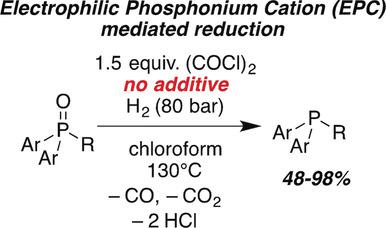当前位置:
X-MOL 学术
›
Angew. Chem. Int. Ed.
›
论文详情
Our official English website, www.x-mol.net, welcomes your
feedback! (Note: you will need to create a separate account there.)
Electrophilic Phosphonium Cation‐Mediated Phosphane Oxide Reduction Using Oxalyl Chloride and Hydrogen
Angewandte Chemie International Edition ( IF 16.1 ) Pub Date : 2018-10-17 , DOI: 10.1002/anie.201809275 Arne J. Stepen 1, 2 , Markus Bursch 3 , Stefan Grimme 3 , Douglas W. Stephan 2 , Jan Paradies 1
Angewandte Chemie International Edition ( IF 16.1 ) Pub Date : 2018-10-17 , DOI: 10.1002/anie.201809275 Arne J. Stepen 1, 2 , Markus Bursch 3 , Stefan Grimme 3 , Douglas W. Stephan 2 , Jan Paradies 1
Affiliation

|
The metal‐free reduction of phosphane oxides with molecular hydrogen (H2) using oxalyl chloride as activating agent was achieved. Quantum‐mechanical investigations support the heterolytic splitting of H2 by the in situ formed electrophilic phosphonium cation (EPC) and phosphane oxide and subsequent barrierless conversion to the phosphane and HCl. The reaction can also be catalyzed by the frustrated Lewis pair (FLP) consisting of B(2,6‐F2C6H3)3 and 2,6‐lutidine or phosphane oxide as Lewis base. This novel reduction was demonstrated for triaryl and diaryl phosphane oxides providing access to phosphanes in good to excellent yields (51–93 %).
中文翻译:

使用草酰氯和氢气还原亲电性磷阳离子介导的氧化膦
使用草酰氯作为活化剂,实现了以分子氢(H 2)对金属氧化物氧化物的无金属还原。量子力学研究支持通过原位形成的亲电phospho阳离子(EPC)和氧化膦进行H 2的杂化裂解,以及随后的无阻转化为膦和HCl。该反应还可以通过由B(2,6-F 2 C 6 H 3)3和2,6-二甲基吡啶或氧化膦作为Lewis碱组成的沮丧Lewis对(FLP)催化。三芳基和二芳基氧化膦证明了这种新颖的还原方法,提供了以良好至极佳收率(51%至93%)的膦原子。
更新日期:2018-10-17
中文翻译:

使用草酰氯和氢气还原亲电性磷阳离子介导的氧化膦
使用草酰氯作为活化剂,实现了以分子氢(H 2)对金属氧化物氧化物的无金属还原。量子力学研究支持通过原位形成的亲电phospho阳离子(EPC)和氧化膦进行H 2的杂化裂解,以及随后的无阻转化为膦和HCl。该反应还可以通过由B(2,6-F 2 C 6 H 3)3和2,6-二甲基吡啶或氧化膦作为Lewis碱组成的沮丧Lewis对(FLP)催化。三芳基和二芳基氧化膦证明了这种新颖的还原方法,提供了以良好至极佳收率(51%至93%)的膦原子。











































 京公网安备 11010802027423号
京公网安备 11010802027423号